Outlining the growing need for multi-faceted solutions using RFID, when large numbers of people require monitored access into and out of public areas such as retail stores, stadiums and libraries
by Mohsen Attaran, California State University
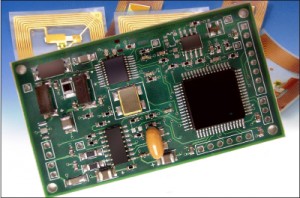 Radio Frequency Identification, or RFID, is one of the most promising and anticipated technologies in recent years. Implemented properly, RFID can save the firm money now–and make the company more competitive for years to come. Despite many useful applications, there are major impediments to RFID adoption in supply chain.
Radio Frequency Identification, or RFID, is one of the most promising and anticipated technologies in recent years. Implemented properly, RFID can save the firm money now–and make the company more competitive for years to come. Despite many useful applications, there are major impediments to RFID adoption in supply chain.
A strong market for RFID technology has been created with the need for optimization of total cost and accurate asset tracking and monitoring. In the past few years, many companies have embraced RFID in their supply chains and are beginning to enjoy real business benefits from the technology. Companies in different sectors have come to realize that RFID technology does a lot more than just tracking boxes in the supply chain. RFID is slowly reemerging as a valuable way to improve internal efficiencies. According to a forecast by ABI Research, the global RFID market will exceed $8.25 billion in 2014, enjoying nearly a 14% compound annual growth rate over the next few years.
Impact
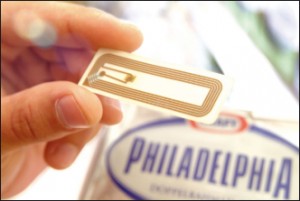 Today, supply chains have to rely on technology to deliver a higher level of performance in satisfying consumer needs. The technology for supply chain management (SCM) is still emerging. Of all the emerging technologies in SMC, RFID has the potential to make the biggest impact. RFID can revolutionize the way the supply chain meets customer expectations by offering direct insight into consumers’ buying habits and increasing efficiency and accuracy within the supply. The technology could dramatically improve supply chain performance by reducing inventory levels, lead times, stock outs and shrinkage rates. It can also increase throughput, inventory visibility, inventory record accuracy, order accuracy, customer service, quality and collaboration among supply chain members.
Today, supply chains have to rely on technology to deliver a higher level of performance in satisfying consumer needs. The technology for supply chain management (SCM) is still emerging. Of all the emerging technologies in SMC, RFID has the potential to make the biggest impact. RFID can revolutionize the way the supply chain meets customer expectations by offering direct insight into consumers’ buying habits and increasing efficiency and accuracy within the supply. The technology could dramatically improve supply chain performance by reducing inventory levels, lead times, stock outs and shrinkage rates. It can also increase throughput, inventory visibility, inventory record accuracy, order accuracy, customer service, quality and collaboration among supply chain members.
Companies face several fundamental challenges when evaluating, planning and implementing RFID in their supply chains.
Obstacles to rapid adoption
Implementing a successful RFID strategy takes time and effort. Implementing a full-fledged system in a large manufacturing company can cost $10 to $25 million. Considering the initial costs of RFID, there is no return on investment (ROI) for companies that implement the technology if compliance is the only pursuit. RFID technology faces numerous implementation challenges. The major challenges include technological maturity, global standardization, government regulations, and cost as summarized in Table 1.
Fundamental
The business benefits that RFID technology offers will not arrive with a big bang. From a supply-chain, manufacturing, or warehouse standpoint, RFID technology has limited applications. There is also a question regarding the “drivers” for adaptation. There must be incentive for retailers and manufacturers to adopt the technology. A return on investment (ROI) is not always a straightforward calculation. Ultimately, a desire on the part of buyers and suppliers to collaborate is necessary to promote the use of RFID.
Technical
Among the technical problems of implementation are imperfect read-rates, unproven systems, and conflicting problems with assembling low-cost tags. RFID is more expensive than bar codes, and problems can occur when using the tags on metal objects. To reduce tag cost the size of the chip needs to be reduced. However, reductions in the size of the chip make assembly of the tags more expensive. Further, technology vendors do not have a clear idea of what RFID middleware should do. Finally, companies often lack in-house experts with the knowledge to implement RFID technology and hiring outside experts can be difficult and expensive.
Security
RFID is a wireless technology and, as such, poses some potential security concerns to users regarding the compromise of data during wireless transmission, storage of data, and security of storage sites. Some of the security issues have been addressed by RFID vendors by employing varying querying protocols, jamming and other techniques.
Privacy issues
The use of RFID could have profound social implications. Without safeguards in place, RFID technology has the potential to compromise consumer privacy and threaten civil liberties. Consumer groups have expressed concern over the privacy invasion that might result with widespread application of RFID tags. Governments around the world regulate the use of the frequency spectrum. There is virtually no part of this spectrum that is available everywhere in the world for use by RFID. This means that a RFID tag may not work in all countries. This ultimately hinders the use of RFID tags in a global environment.
Strategic values
Several factors have contributed to the overall growth of the RFID market as described below and summarized in Figure 1.
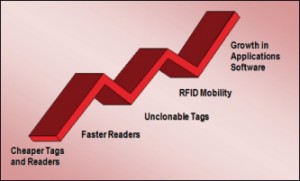 Economic slowdown created major stress for many supply chains. Companies are challenged to keep critical products and supplies moving, manage inventory levels effectively, maintain productivity, improve safety and security, meet compliance requirements and keep emergency transportation costs in check. The inefficiency and lack of responsiveness of traditional SCM systems are highlighted by several empirical studies. According to a study by the Grocery Manufacturers Association, errors occur in 36 percent of consumer packaged goods orders which lead to inventory inaccuracy and are acknowledged as a multi-billion dollar problem. Another study conducted by Efficient Foodservice Response identified more than $800 million in savings available to the foodservice supply chain through more extensive use of technologies like RFID. Data collection by RFID can help prevent errors in order picking and shipping that plague the foodservice industry.
Economic slowdown created major stress for many supply chains. Companies are challenged to keep critical products and supplies moving, manage inventory levels effectively, maintain productivity, improve safety and security, meet compliance requirements and keep emergency transportation costs in check. The inefficiency and lack of responsiveness of traditional SCM systems are highlighted by several empirical studies. According to a study by the Grocery Manufacturers Association, errors occur in 36 percent of consumer packaged goods orders which lead to inventory inaccuracy and are acknowledged as a multi-billion dollar problem. Another study conducted by Efficient Foodservice Response identified more than $800 million in savings available to the foodservice supply chain through more extensive use of technologies like RFID. Data collection by RFID can help prevent errors in order picking and shipping that plague the foodservice industry.
Despite unexpected events and a slowdown in the economy, companies continue to initiate supply chain improvement initiatives based on the growing recognition that excellent supply chain performance has strategic value that can lead to:
- rapid financial payback, often within months;
- improvements in productivity and profits;
- improvements in customer positioning and product quality;
- improvements in safety and security;
- meeting compliance requirements;
- enhancements in long-term relationships with suppliers
There are tremendous cost savings that RFID technology can bring to supply chain operations. According to experts, it is not compliance driving RFID technology; it is the overall savings opportunity. For example, retailers using RFID technology can reduce the costs of receiving, inventory, and shrinkage by 11% to 18%, they can decrease the occurrence of out-of-stock merchandise by 9% to 14%, and they can cut logistical delays by up to 5%.
Another factor influencing adoption is mandates from powerhouses such as Wal-Mart, Target, and others that require the use of RFID-enabled tags for their largest suppliers. In addition, recent technological advances in RFID and a strong industry-wide commitment to standards and investment point to a bright future.
Experts believe the 2009 food-poisoning incidents in the U.S. and the 2010 outbreak of e-coli in Germany highlight the importance of RFID traceability in the food industry. Moreover, RFID technology can provide an efficient, accurate way to comply with regulations such as the Bioterrorism Act and the EU Food Law, which require businesses to collect, process, and store vast amounts of information. These regulations also require timely and accurate information exchange between trading partners. RFID helps organizations throughout the food supply chain gain traceability for compliance and business improvement. Advantages including ease of use, the ability to track individual products packed in crates and to scan items from significant distances help RFID to emerge as the long-term technology of choice in both the pharmaceutical and food industries.
A look ahead
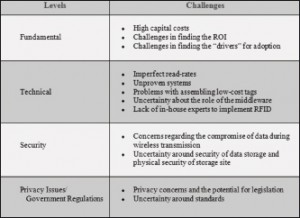 RFID technology is maturing and continues to see tremendous innovation. These technological innovations are discussed below and summarized in Figure 3. Today, RFID systems have further extended capabilities by becoming more expansive and less expensive. RFID tags based on paper, plastic and nontoxic RFID ink are being developed by several companies. Other companies are collaborating to develop active tags that transmit signals up to 600 feet. These active tags have numerous applications in the retail industry and have the ability to move fast into the people-tracking realm. Over the next 10 years, it is expected that retailers will continue to use barcodes and gradually introduce RFID tagging. When the prices of tags become economical, RFID is expected to take off in other venues. Tags could be placed on supermarket products, if the cost per tag was only a penny or two; everything in the shopping cart, except produce, could be read at once.
RFID technology is maturing and continues to see tremendous innovation. These technological innovations are discussed below and summarized in Figure 3. Today, RFID systems have further extended capabilities by becoming more expansive and less expensive. RFID tags based on paper, plastic and nontoxic RFID ink are being developed by several companies. Other companies are collaborating to develop active tags that transmit signals up to 600 feet. These active tags have numerous applications in the retail industry and have the ability to move fast into the people-tracking realm. Over the next 10 years, it is expected that retailers will continue to use barcodes and gradually introduce RFID tagging. When the prices of tags become economical, RFID is expected to take off in other venues. Tags could be placed on supermarket products, if the cost per tag was only a penny or two; everything in the shopping cart, except produce, could be read at once.
Current RFID readers use less power and operate faster, at farther distances, and with more ability to handle interference (Attaran, 2009). Moreover, experts have predicted the average price for readers will be reduced to less than $500 in 2012. Lower costs drive adoption of the product. In addition, using silicon biometrics technology, ‘unclonable’ tags are designed for use in anti-counterfeiting and other related applications. This process prevents counterfeiting of high value, high interest items such as luxury goods, pharmaceutical products, secure IDs and access card embedding.
Closed-loop
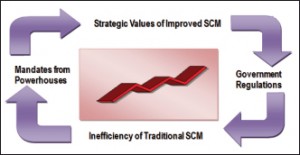 Another possible way to generate value across the enterprise is closed-loop RFID. In this approach RFID technology is used across the enterprise on projects designed to enhance internal corporate application, rather than supply chain operations that share data with other business partners along the supply chains. ‘Closed-loop RFID’ can help streamline a business process, enhance visibility into what customers need, and improve productivity by generating the fastest, lowest cost method of acquiring data within the boundaries of a company.
Another possible way to generate value across the enterprise is closed-loop RFID. In this approach RFID technology is used across the enterprise on projects designed to enhance internal corporate application, rather than supply chain operations that share data with other business partners along the supply chains. ‘Closed-loop RFID’ can help streamline a business process, enhance visibility into what customers need, and improve productivity by generating the fastest, lowest cost method of acquiring data within the boundaries of a company.
Handheld, forklift-mounted and mobile cart readers are changing the paradigm for RFID, opening up new applications. RFID mobility can cut the time it takes to do inventory to a fraction of what it would normally take by bringing readers to the tags instead of passing tags through stationary readers installed at the warehouse doors.
There has also been a tremendous growth in applications software. Microsoft and other software companies are creating platforms upon which RFID resellers and consultants can create software and applications optimized for RFID. Some innovative companies, working with academic and industry leaders, are using hardware and software to develop powerful integrated RFID solutions. In cooperation with university research labs, companies are developing IT processes and applications to improve efficiency in the retail supply chain, with a particular focus on RFID applications that modernize both store operations and the shopping experience. Figure 3 shows evolving growth of RFID technology.
Cutting-edge
Despite economic turmoil, companies still need to invest in cutting-edge solutions so their business can compete and grow. RFID is one solution that can save firms money in the short term, while making their supply chains more competitive in the long run. RFID is one of the most promising and anticipated technologies in recent years. An RFID system solution can increase corporate ROI while at the same time improving retail supply chain communication.
Implemented properly, this technology can bring velocity to certain markets by serving more customers faster and increase customer loyalty. RFID has the real potential to increase accuracy and reliability, enhance service and reduce costs.
Shift in emphasis
In tomorrow’s supply chain, emphasis will shift from manufacturers and retailers pushing products into the value chain to consumers pulling new or customized items into the supply chain. RFID has the potential to offer direct insight into consumers’ buying habits, delivering higher levels of performance in satisfying consumer demands. RFID’s insight into consumer buying habits could also change the way retailers operate, and extends the visibility of the supply chain to anticipate end-of-life and recycling potential. The consumer benefits with better service at a better price.
The challenge for IT experts today is determining how to integrate RFID with existing Supply Chain Management (SCM), Customer Relationship Management (CRM), and Enterprise Resource Planning (ERP) applications within the entire system. While the technology has many benefits to offer, significant stumbling blocks exist. Implementation of RFID involves a variety of issues outside the technology itself: marketing problems, false promises, government regulations, and a lack of standards. Standardization of hardware, software, network protocols and reading devices is important.
Industry members, however, have become painfully aware of these problems and are trying to do something to remedy past mistakes. If they are able to successfully unify the industry with standards, deliver on future promises, and convince end users of the technology’s benefits, then RFID’s future looks favorable.
Using information from published secondary data, a research model has been developed for RFID success to facilitate research integration and variable selection in future research. The model is general and allows new factors or success variables, when identified, to be added easily.
Further empirical research is needed to examine the strength of interrelationships between RFID system benefits and implementation success factors with the overall intent of shaping the adoption of RFID in supply chains and initiating further developments in this discipline. For example, perceptions of RFID professionals could be examined in a cross sectional survey; and regression analysis could be used on survey data to identify the specific factors that are important to each success variable. The objective is to produce an empirically validated list of factors and report their respective strength of impact on various aspects of RFID success.
Since different companies have different objectives or emphases in their supply chain endeavors, the results will be useful in identifying the exact factors that need attention and in providing a basis for prioritizing those factors. The results could also suggest several promising directions for continued research on RFID success.
